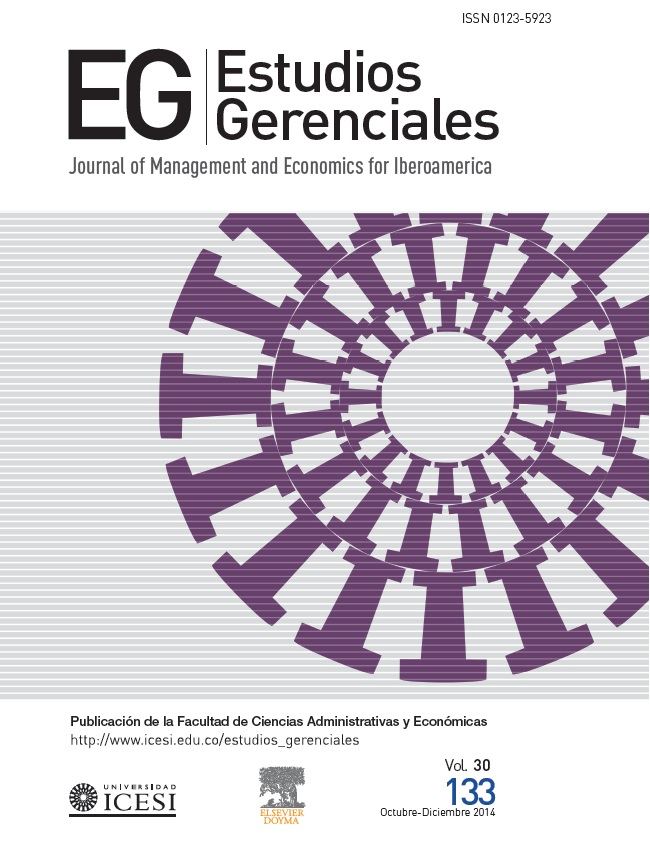Beyond the internal dynamics of organizational responses to conflicting institutional demands
DOI:
https://doi.org/10.1016/j.estger.2014.03.003Palabras clave:
Decision making, Conflicting demands, Institutional theory, StrategyResumen
This paper presents some reflections on strategic response models, in particular the models proposed by Pache, Santos and Oliver, and it evaluates their complementarity and differences, especially regarding the interactions between decision making and the possible strategic responses to institutional demands. It is argued that the theoretical contributions of Pache and Santos can be categorized under the dimension of utility, because they can enhance the potential to operationalize and test the model. However, the reflections made in this paper not only highlight the need to take into account other external and internal factors for the study of strategic responses, but also the integration of different linkages of the decision process with strategic responses to institutional demands.
Descargas
Referencias
Clark, C., & Newell, S. (2013). Institutional work and complicit decoupling across the US markets: The work of rating agencies. Business Ethics Quarterly, 23(1), 1–30.
Cloutier, C., & Langley, A. (2013). The logic of institutional logics: insights from French pragmatist sociology. Journal of Management Inquiry, 22(4), 360–380.
Cohen, M., March, J., & Olsen, J. (1972). A Garbage Can Model of Organizational Choice. Administrative Science Quarterly, 17(1), 1–25.
Corley, K., & Gioia, D. (2011). Building theory about theory building: What constitutes a theoretical contribution? Academy of Management Review, 36(1), 12–32.
Cyert, R., & March, J. (1963). A behavioral theory of the firm. New Jersey: Prentice-Hall. DiMaggio, P., & Powell, W. (1983). The iron cage revisited: institutional isomorphism and collective rationality in organizational fields. American Sociological Review, 48(2), 147–160.
Flingstein, N. (1990). The transformation of corporate control. Cambridge, MA: Harvard Business School.
Goodrick, E., & Salancik, G. (1996). Organizational discretion in responding to institutional practices: Hospitals and cesarean births. Administrative Science Quarterly, 41(1), 1–28.
Goodstein, J. (1994). Institutional pressures and strategic responsiveness: Employer involvement in work-family issues. Academy of Management Review, 37(2), 350–382.
Greening, D., & Gray, B. (1994). Testing a model of organizational response to social and political issues. Academy of Management Review, 37(3), 467–498.
Gupta, S. (2009). How do consumers judge celebrities' irresponsible behavior? An attribution theory perspective. Journal of Applied Business and Economics, 10(3), 1–14.
Jarzabkowski, P. (2004). Strategy as practice: recursiveness, adaptation, and practices in use. Organization Studies, 25(4), 529–560.
Kostova, T., & Zaheer, S. (1999). Organizational legitimacy under conditions of complexity: The case of the multinational enterprise. Academy of Management Review, 24(1), 64–81.
Langley, A., Mintzberg, H., Picher, P., Posada, E., & Saint-Macary, J. (1995). Opening up decision making: The view from the black stool. Organization Science, 6(3), 260–279.
Lawrence, T. (1999). Institutional strategy. Journal of Management, 25(2), 161–188.
March, J., & Simon, H. (1958). Organizations. New York: Wiley.
Meyer, J., & Rowan, B. (1977). Institutionalized Organizations: Formal structure as myth and ceremony. The American Journal of Sociology, 83(2), 340–363.
Oliver, C. (1991). Strategic responses to institutional processes. Academy of Management Review, 16(1), 145–179.
Pache, A. C., & Chowdhury, I. (2012). Social entrepreneurs as institutional embedded entrepreneurs: Toward a new model of social entrepreneurship education. Academy of Management Learning & Education, 11(3), 494–510.
Pache, A. C., & Santos, F. (2010). When worlds collide: The internal dynamics of organizational responses to conflicting institutional demands. Academy of Management Review, 35(3), 455–476.
Pache, A. C., & Santos, F. (2013). Inside the hybrid organization: Selective coupling as a response to competing institutional logics. Academy of Management Journal, 56(4), 972–1001.
Scott, R. (2005). Institutional theory: Contributing to a theoretical research program in great minds in management. In K. Smith, & M. Hitt (Eds.), The process of theory development. London: Oxford University Press.
Seo, M., & Creed, D. (2002). Institutional contradictions, praxis, and institutional change: A dialectical perspective. Academy of Management Review, 27(2), 232–247.
Simon, H. (1979). Rational decision making in business organizations. The American Economic Review, 69(4), 493–513.
Smets, M., Morries, T., & Greenwood, R. (2012). From practice to field: A multilevel model of practice-driven institutional change. Academy of Management Journal, 55(4), 877–904.
Whetten, D. (1989). What constitutes a theoretical contribution? Academy of Management Review, 14(4), 490–495.
Zucker, L. (1977). The role of institutionalization in cultural persistence. American Sociological Review, 42(5), 726–743.
Descargas
Publicado
Número
Sección
Licencia
Los autores de artículos serán responsables de los mismos, y por tal no comprometen los principios o políticas de la Universidad Icesi ni las del Comité Editorial de la revista Estudios Gerenciales. Los autores autorizan y aceptan la cesión de todos los derechos a la revista Estudios Gerenciales, tanto en su publicación impresa como electrónica. Luego de publicado el artículo, puede ser reproducido sin autorización, mencionando autor(es), título, año, volumen, número y rango de páginas de la publicación, y como fuente: Estudios Gerenciales (abstenerse de usar Revista Estudios Gerenciales).








